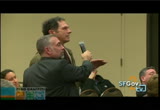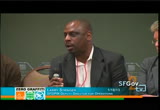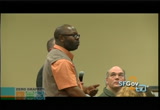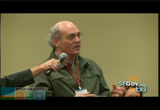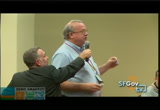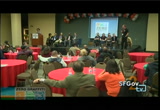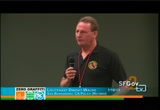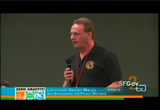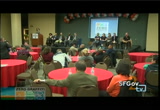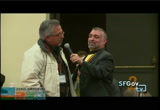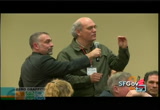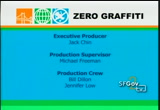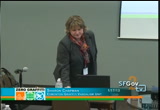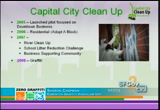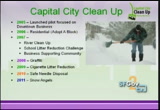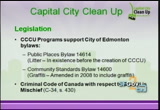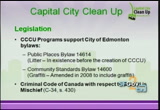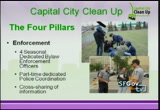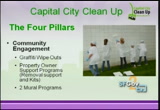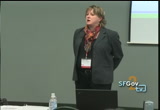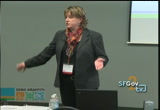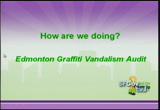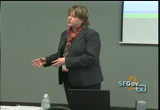tv [untitled] April 21, 2013 4:14pm-4:44pm PDT
4:14 pm
paint over it. it's got to be power washed. you have to use -- that can be really expensive. they went and painted over it. and now it looks worse than the graffiti. i see it all over the city that a tag is painted over with brown paint, with whatever is available. and then it becomes a real problem because it's really hard to remove it then. so, i think that -- my thought about it, i know dpw doesn't have the financial resources, but realistically i think sidewalks even though they're kind of that nebulous gray area where technically they're owned by the property owner, but they really are public property. and i think that's something that dpw should somehow find the funding to take care of that property because private property owners are not going to hire somebody with a power washer to come out there and do it. i just know it. i mean, i see very, very few examples of that. >> larry. >> i would agree.
4:15 pm
but as always, it's an issue of funding. we do have approved product listses on our website. so, if you run into somebody, there are some there they can use and actually work relatively well. but the ultimately cities face this all the time. you have to make decisions about what resources you have and what you can and can't do with the resources that you have. and, so, that's going to continue to be a problem. and it's always about the decisions, what you can do and what you can't. and while it's understandable, as long as they're abating the graffiti, and i understand it doesn't look nice to have a sidewalk painted, but my reference would be tell them about the other products that are out there. and i'm not -- not all of the tags require a power washer to take it off. >> i'm going to speak as a property owner. >> go for it. >> i live in alameda.
4:16 pm
this was not graffiti, this was trees, replanting trees, they want to put a tree, who is responsible for that, sidewalks and everything. one thing they did do is they offered referrals for contractors, not just materials, but, you know, people who could do the trees or who could do the sidewalk repairs or what have you. so, that might be another option for different municipalities that help theirs. but that helped get her done. >> [speaker not understood]. >> go ahead. >> [speaker not understood]. [speaker not understood]. they know where to actually get power washers and things like that from home depot. they offer that information to the residents and that way that is something that is also helpful. so, there is another avenue
4:17 pm
there. >> go ahead. you want to add -- >> i wanted to add to this subject. going back to ghosting, there is a same situation with sidewalks. actually, i'm a contractor so i know. you need to have a lot of power on your power washer, a specific amount of pressure in order to be able to take some of the graffiti on the sidewalks. one point i haven't heard talked in this conference is an issue that has a lot to do with ghosting is that vandals are coming up with new concoctions of paints that they use to make it harder to take out. so, i say that graffiti abatement is a combination of science and alchemy. because every time you get to a place, a small percentage you find pigments that's like from another world almost.
4:18 pm
but just to finalize, and i understand what larry was answering. it makes sense that you cannot hold property owners liable to graffiti ghosting. but is this a point of policy that maybe could look forward? other municipalities, that whenever there is ghosting, you actually encouraging more vandalism because that is an etch that is going to stay -- my grandchildren might still see it. so, what i'm saying is i think dpw does a great job on giving referrals on contractors, by the way, and a wealth of information about products. but the bottom line is that property owner is only going to spend so much money over and over and over and get to a point that it's just too much money. so, ghosting i think to me is dear to my heart because of this. if it stays there it's going to
4:19 pm
attract more vandalism. >> great point, thank you. jan, do you want to read another question? >> yes, this is in regards to abatement and it's something that as a city we have issues with, too, so i would like an answer. is there a product that would clean [speaker not understood] without damaging reflective coating? i've used different brands with no luck and i end up replacing the sign. so, in your experience [speaker not understood]? oh, okay. >> [speaker not understood]. i've got a sign outside my house at home. somebody tagged my sign. so, i went out there and when i got done, there was no red paint left, just a big shiny reflective piece. so, i called up the city of highland and i said, my sign looks like crap. they said that's fine. you must have one of the old signs. and 3m is putting out a material, it's being used by our city and every one of our
4:20 pm
"street signs" come down. when a street sign comes down, san beerctionv dino does it, a lot of cities in california are doing it. san bernardino. * when you wipe it off it allows you to wipe the paint off. you don't get the run and such. so we're seeing more and more of it being used in california. you still have to clean it. it doesn't keep it from sticking, but it preserves the signs, don't have to keep changing the signs. >> all right. so, i want to actually ask a question of the attendees. was there anything about this conference that you can -- because basically we all live graffiti. graffiti is our live. we deal with it on a daily basis. anybody here come to this conference and whether it's from the panel or somebody that they spoke to here, one of the vendors that were here, that was something totally new, something you've never heard of before, something brand spanking new for you and something you want to take home with you to share with other people? chuck?
4:21 pm
>> we're launching our education program in the schools. the idea of having the kids do some artwork and then turn around and tag it in their class. so, they feel what it's like to be violated. that is so powerful, i can't wait to get home and start doing it. on the other side as a carrot, i have stickers. when you give blood like i do every eight weeks, they give me a little sticker. that says, be nice to me, i gave blood today. [speaker not understood]. we need to do that for our clean-up people. so, when i take one of our felons, our misdemeanor kids and we go out and abate graffiti, at the end of the day i put a sticker on and says, be nice to me, i cleaned hayward today. your parents have to be nice to you and you tell them i said so. (applause)
4:22 pm
>> awesome, thank you. thank you. do you have another question up there? >> i do. >> okay, great. >> it's a rather hefty one. there is much more commercial tagging such as billboards, rap ads on buses, streetcars, structures built into sidewalks such as kiosks, news gras being, stand alone in ground billboards, and tagging by individuals. also people have become used to constant advertising. if we are wanting to make our city more beautiful, how do we handle commercial tagging? doesn't the amount of advertising in public space affect us? does anyone want to take that? anyone want to tackle that one? >> i'll throw a little bit on that one. again, you know, the constitution has a real issue in america where we have freedom of speech. and just because something -- artwork that appears to be graffiti does not make it
4:23 pm
illegal. and the corporations know that graffiti is one of the edge things that draws youth and draws vibrance and it's a sign of being, you know, alive and active. you see it in all kinds of advertising and it's going to continue. the only way around it, i know there have been some contacts with certain corporations where they had it drawn to their attention, made a mistake and they would change. and that's the only way you can do it is dealing with the corporation itself. and that is going to be very difficult because as you saying i don't like this versus, hey, we're selling $10 million worth of product this year and a lot of it is off of our graffiti campaign. when i show some of my stuff in -- we talk about commercial graffiti, there's a bunch of stuff in conon el, a toilet paper commercial. they had graffiti built onto
4:24 pm
each one of their toilet paper ads. they weren't getting bang for their buck and they got rid of t. there was a commercial from esther c. there was a supplement, a little orange and you ran around and saw graffiti and heard the police chasing him and stuff. i quoted that to the joe camel thing. kids look at that and think graffiti is cool. they received a lot of pressure and they pulled those ads. but you have the opposite side where you have like mountain dew where they go out and find 10 or 12 different taggers they think are great, design custom mountain cans, extreme games is the thing they're pushing and they get a lot of input from that. they have a website and guys go out collecting cans reading about the poor vandals grew up on the mean streets, now they're artists because they have their own personal cans.
4:25 pm
we can't regulate what isn't personal constitution. if you can provide an economic impact, we as adults are looking at this and we don't want to deal with it, if you have any thought about this, contact randy campbell at no graffiti network. he's been battling against coca cola and their graffiti stuff for years and years and years. he can tell you what kind of battle that is legally. so, it's kind of the side effect of living in a free country. >> awesome, thank you. i believe you had a question here. did you have your hand up? mine was a pretty good question. let's see what other answers we have. >> i'm the general services manager for our public works department which means i have 36 [speaker not understood] of program responsibility. and graffiti is the 36th. so, i really appreciate, especially dr. spencer and some of the other panelists who kind of help bring home some of the
4:26 pm
key points about how graffiti really is a gateway crime and how graffiti vandals escalate. and that's one, if any message i can take home, that's what i really want to so i thank you for that. omaha, nebraska. >> omaha, nebraska. you have one up there? >> i'm all done. >> do you have a question you wanted to ask? >> [speaker not understood]. >> we'll get to the sales pitches, okay. [laughter] >> okay. anybody else here, let me come over here because we're going to start wrapping this up pretty soon because we have some awards we're going to give out. okay. i'm going to hold the mic and i'll determine how quick it's going to be, okay. [laughter] >> just to compliment the city of san francisco. i was on -- i took the muni in yesterday. and when i was on the bus in the morning, there is a repetitive announcement that went out that said, if you see graffiti, report it.
4:27 pm
and here's the phone number. it went out, i believe in three languages. that's wonderful. i think that's more key than if you hit the raid yoxtion and all that sort of media thing and grab that piece. * radio those are the people that are out there. >> awesome. if anybody has compliment for san francisco let me know because we can put that in right now. [laughter] >> alex, you live here. hold on. let me get over to you quickly and then we'll have you -- >> the one thing that i really got from catherine's presentation that really touched me was she was telling us to go forward 2030 in term of technologies and looking back to today. but this conference with all the vendors we had here had an amazing impact on me as learning of new technologies. i really feel in the 21st
4:28 pm
century of different types of technologies. i'm not going to make any pitches here. but bottom line is we are learning and this conference to me, and i know for many of us here, it was a great learning experience. thank you. >> awesome, thank you. (applause) >> thank you. all right. if we don't have any more questions, i'm going to give it over to drew to do his little sales pitch up there. or any announcements that need to be made. >> [speaker not understood]. >> okay, do you want the microphone? i'll hold it. i'm kidding. here you go. >> i'm obviously part of the nonprofit [speaker not understood], i have a products company. and for what it's worth, it hasn't gone to development yet. but we have a one-coat film that so far is working on traffic signs with unlimited cleanings. once it goes to market we'll let you know at the 2013 conference. we're not quite there yet, but it is close. the films can be difficult to apply on signs and very labor
4:29 pm
intensive, but the sign shops something you'll be able to apply yourself. when it comes to completion, all graffiti [speaker not understood] will get a sample. can (applause) * >> okay. so, we have a couple minutes. if there's no more questions, no more compliments, the panel, thank you so much for coming. (applause) >> it's been awesome. hopefully we'll be having another one next year somewhere in the world. ... . >> hi, my name is sharon, i'm
4:30 pm
the graffiti project manager for the city of edmonton, canada. for some of you weren't in my presentation earlier today i'll go through what the city of edmonton is doing in terms of programming but then go through auditing and what we do. capital city clean up brings cities together to create safe, clean inviting xhueplts and neighborhoods. our motto is a clean and safe edmonton is a shared responsibility and we work on the premise that we can't do it alone, that we need to work as partners with the community to create solutions to graffiti vandalism and litter enforcement. just a technical point, if any of you want to ask questions, they are recording the session
4:31 pm
so they would like you to speak into the microphone and if you have any questions along the way, please feel free to ask. when did capital city clean up start? it was launched in 2005 as a pilot program focused on litter reduction in the downtown of edmonton. basically businesses were asked to adopt a block in their area and were responsible for litter clean up in that area and the program had such a huge success that they expanded the program in 2006 to include a residential component for litter pick-up. we now have over a thousand adopt a block captains that are responsible for adopting blocks around the city of edmonton for picking up litter and they each have crews of 4 to 5 thousand people so so we have four to five thousand people picking up
4:32 pm
litter. we link nonprofit organizations with businesses and the businesses pay the nonprofit organizations $650 per summer to have the nonprofits pick up litter in the blocks surrounding their business. the advantage to that is, again, community responsibility. they're not just picking up litter at the businesses, they are picking up litter in the surrounding blocks. we have a school litter reduction program that was started that year as well so we focus on educating schools on litter pick-up in the city. in 2008 the program was expanded to include graffiti and 2008 was when our by law was amended requiringing property owners it remove graffiti from their property or face a $250 crime. the one success from our program was the council at that time looked at the idea that we can't hold citizens responsible if we're not responsible ourselves, so they created our management program at that time. that
4:33 pm
includes bylaw enforcement as well as civic clean up and support for property owners. the program expanded again in 2009 to include a cigarette litter reduction program. we have a huge problem in our city with cigarette litter. we found that through our litter audits that we have done, we have a higher rate of cigarette litter in our cities compared to other cities in canada. expanded again in 2010 to include needle disposal and i said in the other session, this is what i am escaping from in edmonton right now. yay, san francisco. so we have a snow angel program where we ask citizens to voluntarily shovel the snow off their neighbor's lawns. so these are all the programs offered by the capital city clean up program. we started in 2005 as part of the waste management branch and
4:34 pm
this past year in 2012 we were moved to the community standards branch which is where we are housed now. so we have a very strong link with our programs between the programs that we offer and the community standards or community bylaw ordinances that we're operating under. the lation that we focus in on is 14614, that is the bylaw that governs litter pick up in the city. community standards 146400 is the graffiti standards bylaw. our bylaw is unique to other cities in that we don't focus on the definition of graffiti, we focus on whether or not graffiti is considered a nuisance on a property. so the bylaw is written such that it has to fall within the definition of community standards, the nuisance property and therefore we're
4:35 pm
not ever restricted by a definition and people arguing whether what's on there fits within a specific definition of graffiti, it all falls within whether what is on the building constitutes a nuisance. it also gives strength to it because we don't run into the possibility if somebody says that, well, i want it there because i gave permission to it, permission is not a factor, it's whether or not it's a nuisance property. in canada some jurisdictions have their bylaws such that they can charge taggers with fines for doing graffiti tagging. we don't have any such ordinance in our city. graffiti is managed on the enforcement side as a crime under the criminal code of canada. so just quickly i won't go through all of our programs, i did an hour and a half so i could talk forever on our programs. but basically we have our programs for our city
4:36 pm
are divided into 4 areas. civic operations, we have two graffiti removal vans that clean graffiti on our civic property alone. we do enhanced clean up, we have a contractor that does some additional clean up on city property as well as the clean up that's done by operational departments in the city. and interdepartment coordination is key. we have an operations department, operations committee that's made up of representatives from all the operations areas in the city and through that we coordinate all of our clean up on city infrastructure and we have all of our complaints come in through 311, which is the recording for the city of edmonton for all -- any complaint, recreation sign up, anything comes through 311. but we do manage our calls through that service.
4:37 pm
we have 4 seasonal bylaw officers that are dedicated to graffiti enforcement. this is -- yeah? >> how many people live in edmonton? >> there's about a million people in edmonton there's about a million. we have 4 seasonal officers that work only on graffiti. cost sharing of information of our programs is critical. our bylaw complaints, all the information that's gathered in our bylaw system is, includes information that would be of value to police. so not only do we keep information on which properties are hit, all the tagger information in the city
4:38 pm
is also tracked through our bylaw system and whenever police are going to make any arrests they have access to our bylaw system. that information is, because it's collected by bylaw, it's prepared and enforcable in a court of law so our officers are able to increase their arrests by accessing our bylaw information. our biggest arrest last year, 167 charges were laid against one person and half of that came through our bylaw system. we offer property owner support program and kits. kits
4:39 pm
are available free of charge, they include a discount on paint from roano which is the equivalent of lowe's or home depot. property owners can access our contractor up to $500 in value to have the contractor go and remove graffiti on the property owner's property free of charge up to $500, then the property owner is responsible for the balance, but last year 97 percent of the program participants got the graffiti removed by free. what we found was by offering those two programs alone, we found not only do we have a 99.37 compliance rate on our bylaw enforcement, but negative public perception about the bylaw has gone down significantly. i used to get two calls a week of people complaining about the bylaw, i don't get any of it now because
4:40 pm
we're able to defuse it by telling them about the support programs. i've been talking all afternoon. we also offer two mural programs, one that we fund ourselves directly and one that we offer community groups $2,000 to paint murals in the community. the idea is that that program is a matching program so community groups can match up to $2,000 with any type of community effort so they can get an artist to donate the art work, you can get somebody to donate paint, their volunteer hours count against the matching, so all of that is helpful in terms of getting them going. and what we really found is that some groups will use the two thousand and spend 12,000 on doing a mural. the best one i've seen, we had a high school do two dugouts that were constantly being hit, it cost them $750 and we have no problem with the dugouts any
4:41 pm
more. public awareness, we have a very, very substantial public awareness campaign. we have media support from all of our local radio, television and print media outlets and the other presentation i did, if anyone is interested i can show you some of the clips but we have basically almost every radio station in town is producing -- and television station in town is producing video clips they are airing for us, promoting our programs, calling 311, et cetera. so it's been very beneficial. we do conferences and workshops, we hosted the tags conference in edmonton last year, we're developing school programs, we have a program designed for grade 6 students, we're looking at a restoretive program this year so we're very active in the community. so that's our program in a nutshell, 15 minutes and it doesn't really give it justice to some of the nuances but it gives you a sense of the different types of activities
4:42 pm
that we're doing. so what does that mean? we've been doing a lot, how are we doing, how is edmonton really doing? what we found when we started the program, i was thrown in, in 2008, they said come up with a graffiti program. i know nothing about graffiti, i'm a communications director and i manage projects so how am i going to come up with what we are doing. we had someone on light duty from the corporate properties department going around in neighborhoods in our business revitalization zones trying to count and tell us how much graffiti was there. well, that was all very well and good but the graffiti we could find was only, the numbers were only significant to the capabilities of the person that was finding it. it wasn't giving us any real sense of whether we were increasing in graffiti vandalism, whether it was decreasing. we had been working with mgm management on our litter
4:43 pm
audits, we had been doing capital city clean up starting in 2007 started doing litter audits where we hired mgh management -- mark is the auditor who do our litter audits and now was doing our graffiti audits. basically, we looked at what we were doing on our litter audit and said there's got to be a more scientific, for lack of a better way, or statistical way of looking at how much graffiti was in a city and how we were really doing. so what we did -- so why do an audit? graffiti is a property vandalism crime. information we share from our audits are shared with bylaw and police and affect our enforcement and programming efforts. so what we're doing is taking the information that we gather from our audits and we're changing our programming accordingly. so i am able to track what's going on in each neighborhood to determine where i ne
63 Views
IN COLLECTIONS
SFGTV2: San Francisco Government Television Television Archive
Television Archive  Television Archive News Search Service
Television Archive News Search Service 
Uploaded by TV Archive on

 Live Music Archive
Live Music Archive Librivox Free Audio
Librivox Free Audio Metropolitan Museum
Metropolitan Museum Cleveland Museum of Art
Cleveland Museum of Art Internet Arcade
Internet Arcade Console Living Room
Console Living Room Books to Borrow
Books to Borrow Open Library
Open Library TV News
TV News Understanding 9/11
Understanding 9/11
